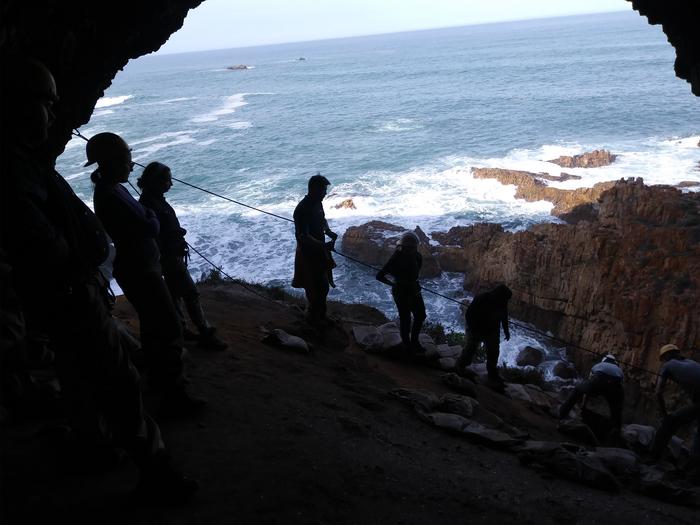In a remarkable archaeological discovery in a cave on the southern coast of South Africa, researchers uncovered an extensive assemblage of ancient stone tools, dating back approximately 20,000 years. These findings, detailed in a comprehensive study published in the Journal of Paleolithic Archaeology, provide invaluable insights into the cognitive abilities and cultural practices of prehistoric humans. By meticulously analyzing the microscopic features of the chipped edges of these tools, the researchers gained insightful data about the techniques these early humans employed in their day-to-day activities, which included hunting and crafting.
Dr. Sara Watson, a postdoctoral scientist at the Field Museum’s Negaunee Integrative Research Center, spearheaded the research, emphasizing the significance of these tools in understanding the lifestyle adaptations of humans in this region during a time when the Earth was nearing the end of the last major ice age. During this period, between 24,000 and 12,000 years ago, the sea levels were considerably lower due to the majority of Earth’s water being trapped in glaciers and ice caps. As a result, the current coastline was several miles inland, transforming the area into vast grasslands abundant with large game animals, specifically antelope. This storied history of the landscape reveals a transformative time where prehistoric humans adapted their hunting strategies and tool-making practices in response to their environment.
As the researchers delved deeper into their findings, the excavation process itself presented unique challenges and required extraordinary care. The location of the cave brings a curious juxtaposition; perched atop a 75-foot cliff that provides an expansive view of the ocean, these caves now overlook a rocky beach rather than the open plains that would have existed thousands of years ago. The extraction of these invaluable artifacts demanded not only physical resilience, with researchers hauling up to 50 pounds of excavation and photography equipment, but also a meticulous approach. The team utilized delicate dental tools and miniature trowels, allowing them to extract individual layers of sediment carefully, thereby preserving the archaeological context of the tools.
Within the layers of sediment, the team unearthed thousands of stone implements, from small sharp blades to the larger cores from which these blades were crafted. Contrary to popular perception, it is these cores that tell a compelling story about the specific methods and processes employed by these early humans during tool production. Each core bears the marks of intentional craftsmanship, reflecting a learned technique that may have been passed down through generations, thus embedding social and historical contexts within their creation.
Examining the varying patterns of core reduction among the excavated stone tools, Watson noted distinct methodologies employed across different tools that convey essential cultural and social information. The presence of specific techniques observed at multiple sites suggests a complex web of interaction and idea-sharing among prehistoric communities. This communal knowledge transfer is indicative of richer social networks than previously assumed, hinting at a society capable of intricate communication and cultural exchange.
One notable methodology that stood out to Watson was a specific technique for obtaining small bladelets from cores, closely resembling similar practices documented hundreds of miles away in regions such as Namibia and Lesotho. The consistency in core reduction patterns across such vast distances strongly suggests an intentional cultural exchange rather than mere coincidence, indicating that these prehistoric peoples actively shared technological knowledge.
As the contemporary narrative surrounding archaeology continues to evolve, insights like those drawn from the extensive examination of the Robberg caves underscore the long and rich tapestry of human history. These findings illuminate the advanced capabilities of humans living at the cusp of significant climatic changes and demonstrate that despite the physical and environmental challenges these groups faced, they developed complex strategies for survival. The adaptability and ingenuity of these early societies match modern sensibilities more closely than many might presume.
Watson emphasized the importance of continued research into sites like the Robberg caves, reiterating that our understanding of prehistoric cultures remains an unfinished puzzle. With every new discovery, researchers highlight the complex relationship our ancestors had with their environment as they developed tools suited for both survival and social interaction. The techniques they honed not only facilitated their survival but also laid the groundwork for cultural advancements that would follow.
As modern scientists continue unearthing layers of history concealed within these ancient sites, it becomes increasingly clear that the narrative of humanity is deeply layered with shared experiences, struggles, and technological innovations. The path to uncovering these narratives is beset with challenges, yet with each excavation reveals the incredible stories of resilience, creativity, and adaptive strategies of our ancestors.
In summary, the findings from the Robberg caves underscore not only the physical capabilities of ancient humans but also their social, cultural, and technological complexity. Each tool acts as a reminder of the intricate dance between humanity and the environment, shedding light on what it meant to be human during a time vastly different yet intrinsically connected to our contemporary lives.
The study showcases the importance of interdisciplinary collaboration among archaeologists, historians, and scientists as they strive to piece together the rich, diverse tapestry of human history. As technology advances, it will undoubtedly aid in further revealing the intricate details of our past and refining our understanding of how ancient societies functioned, interacted, and adapted over thousands of years.
Subject of Research: Stone tools from ancient humans in South Africa
Article Title: Robberg lithic technology from Knysna Eastern Heads Cave 1
News Publication Date: 9-Apr-2025
Web References: DOI: 10.1007/s41982-025-00214-5
References: Journal of Paleolithic Archaeology
Image Credits: Credit: Sara Watson
Keywords: Anthropology, Archaeology, Stone tools, Prehistoric archaeology, Social research, Material culture, Homo sapiens, Caves, Archaeological sites, Archaeological periods




